This web page provides only the official AKC Standard for the breed. Breeders, judges,
exhibitors, and those wanting to learn about the structure of the Standard Schnauzer
will find the book,
The Standard Schnauzer Illustrated,
a MUST. This wonderful book has written
and visual explanations of the official AKC standard as well as visual examples of faults.
GENERAL APPEARANCE
The Standard Schnauzer is a robust, heavy-set dog, sturdily built with good muscle and
plenty of bone; square-built in proportion of body length to height. His rugged
build and dense harsh coat are accentuated by the hallmark of the breed, the
arched eyebrows and the bristly mustache and whiskers. Faults--Any deviation
that detracts from the Standard Schnauzer's desired general appearance of a robust,
active, square-built, wire-coated dog. Any deviation from the specifications in the
Standard is to be considered a fault and should be penalized in proportion to the
extent of the deviation.
SIZE, PROPORTION, SUBSTANCE
Ideal height at the highest point of the shoulder blades, 18.5 to 19.5 inches for
males and 17.5 to 18.5 inches for females. Dogs measuring over or under these limits
must be faulted in proportion to the extent of the deviation. Dogs measuring more
than one half inch over or under these limits must be disqualified. The height at
the highest point of the withers equals the length from breastbone to point of rump.
Head strong, rectangular, and elongated; narrowing slightly from the ears to the eyes and again to the tip of the nose. The total length of the head is about one half the length of the back measured from the withers to the set-on of the tail. The head matches the sex and substance of the dog. Expression alert, highly intelligent, spirited. Eyes medium size; dark brown; oval in shape and turned forward; neither round nor protruding. The brow is arched and wiry, but vision is not impaired nor eyes hidden by too long an eyebrow.
Ears set high, evenly shaped with moderate thickness of leather and carried erect when cropped. If uncropped, they are of medium size, V-shaped and mobile so that they break at skull level and are carried forward with the inner edge close to the cheek. Faults--Prick, or hound ears.
SKULL
( Occiput to Stop ) moderately broad between the ears with the width of the skull not exceeding two thirds the length of the skull. The skull must be flat; neither domed nor bumpy; skin unwrinkled. There is a slight stop which is accentuated by the wiry brows. Muzzle strong, and both parallel and equal in length to the top skull; it ends in a moderately blunt wedge with wiry whiskers accenting the rectangular shape of the head. The top line of the muzzle is parallel with the top line of the skull. Nose is large, black and full. The lips should be black, tight and not overlapping. Cheeks--Well developed chewing muscles, but not so much that "cheekiness" disturbs the rectangular head form.
BITE
A full complement of white teeth, with a strong, sound scissors bite. The canine teeth are strong and well developed with the upper incisors slightly overlapping and engaging the lower. The upper and lower jaws are powerful and neither overshot nor undershot. Faults--A level bite is considered undesirable but a lesser fault than an overshot or undershot mouth.
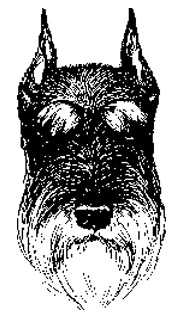
Neck strong, of moderate thickness and length, elegantly arched and blending cleanly into the shoulders. The skin is tight, fitting closely to the dry throat with no wrinkles or dewlaps. The topline of the back should not be absolutely horizontal, but should have a slightly descending slope from the first vertebra of the withers to the faintly curved croup and set-on of the tail. Back strong, firm, straight and short. Loin well developed, with the distance from the last rib to the hips as short as possible.
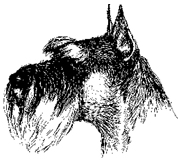
The body compact, strong, short-coupled and substantial so as to permit great flexibility and agility. Faults -Too slender or shelly; too bulky or coarse.
Chest of medium width with well sprung ribs, and if it could be seen in cross section would be oval. The breastbone is plainly discernible. The brisket must descend at least to the elbows and ascend gradually to the rear with the belly moderately drawn up. Fault--Excessive tuck-up. Croup full and slightly rounded. Tail set moderately high and carried erect. It is docked to not less than one inch nor more than two inches. Fault Squirrel tail.
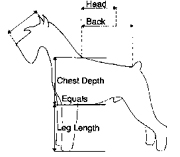
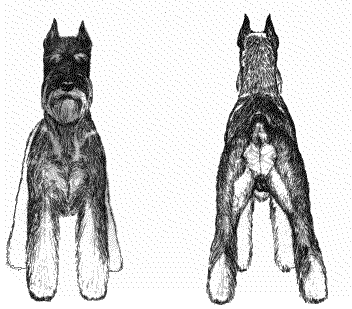
Shoulders-The sloping shoulder blades are strongly muscled, yet flat and well laid back so that the rounded upper ends are in a nearly vertical line above the elbows. They slope well forward to the point where they join the upper arm, forming as nearly as possible a right angle when seen from the side. Such an angulation permits the maximum forward extension of the forelegs without binding or effort. Forelegs straight, vertical, and without any curvature when seen from all sides; set moderately far apart; with heavy bone; elbows set close to the body and pointing directly to the rear. Dew claws on the forelegs may be removed. Feet small and compact, round with thick pads and strong black nails. The toes are well closed and arched (cat's paws) and pointing straight ahead.
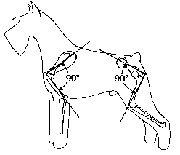
HINDQUARTERS
Strongly muscled, in balance with the forequarters, never appearing higher than the shoulders.
Thighs broad with well bent stifles. The second thigh, from knee to hock,
is approximately parallel with an extension of the upper neck line. The legs,
from the clearly defined hock joint to the feet, are short and perpendicular
to the ground and, when viewed from the rear, are parallel to each other. Dew claws,
if any, on the hind legs are generally removed. Feet as in front.
COAT
Tight, hard, wiry and as thick as possible, composed of a soft, close undercoat and a
harsh outer coat which, when seen against the grain, stands up off the back, lying
neither smooth nor flat. The outer coat (body coat) is trimmed (by plucking) only to
accent the body outline.
As coat texture is of the greatest importance, a dog may be considered in show coat
with back hair measuring from 3/4 to 2 inches in length. Coat on the ears, head, neck,
chest, belly and under the tail may be closely trimmed to give the desired typical appearance
of the breed. On the muzzle and over the eyes the coat lengthens to form the beard and eyebrows;
the hair on the legs is longer than that on the body. These "furnishings"
should be of harsh texture and should not be so profuse as to detract from the neat
appearance or working capabilities of the dog. Faults--Soft, smooth, curly, wavy or shaggy;
too long or too short; too sparse or lacking undercoat; excessive furnishings; lack of furnishings.
COLOR
Pepper and salt or pure black.
Pepper and Salt-The typical pepper and salt color of the topcoat results from the combination
of black and white hairs, and white hairs banded with black. Acceptable are all shades of
pepper and salt and dark iron gray to silver gray. Ideally, pepper and salt Standard Schnauzers
have a gray undercoat, but a tan or fawn undercoat is not to be penalized. It is desirable to
have a darker facial mask that harmonizes with the particular shade of coat color. Also,
in pepper and salt dogs, the pepper and salt mixture may fade out to light gray or silver
white in the eyebrows, whiskers, cheeks, under throat, across chest, under tail, leg furnishings,
under body, and inside legs.
Black - Ideally the black Standard Schnauzer should be a true rich color, free from any
fading or discoloration or any admixture of gray or tan hairs. The undercoat should also
be solid black. However, increased age or continued exposure to the sun may cause a certain
amount of fading and burning. A small white smudge on the chest is not a fault. Loss of
color as a result of scars from cuts and bites is not a fault.
Faults - Any colors other than specified, and any shadings or mixtures thereof in
the topcoat such as rust, brown, red, yellow or tan; absence of peppering;
spotting or striping; a black streak down the back; or a black saddle without
typical salt and pepper coloring-and gray hairs in the coat of a black; in blacks,
any undercoat color other than black.
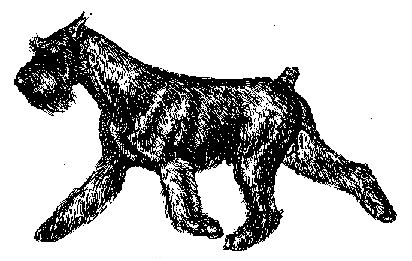
GAIT
Sound, strong, quick, free, true and level gait with powerful, well angulated hindquarters
that reach out and cover ground. The forelegs reach out in a stride balancing that of the
hindquarters. At a trot, the back remains firm and level, without swaying, rolling or
roaching. When viewed from the rear, the feet, though they may appear to travel close
when trotting, must not cross or strike. Increased speed causes feet to converge
toward the center line of gravity.
Faults
Crabbing or weaving; paddling, rolling, swaying; short, choppy, stiff, stilted
rear action; front legs that throw out or in (East and West movers);
hackney gait, crossing over, or striking in front or rear.
TEMPERAMENT
The Standard Schnauzer has highly developed senses, intelligence, aptitude for training,
fearlessness, endurance and resistance against weather and illness. His nature combines
high-spirited temperament with extreme reliability.
Faults - In weighing the seriousness of a fault, greatest consideration should be given
to deviation from the desired alert, highly intelligent, spirited, reliable character
of the Standard Schnauzer. Dogs that are shy or appear to be highly nervous should be
seriously faulted and dismissed from the ring. Vicious dogs shall be disqualified.
DISQUALIFICATIONS
Males under 18 inches or over 20 inches in height. Females under 17 inches
or over 19 inches in height.
Vicious dogs.
Approved February 9, 1991
Effective March 27, 1991